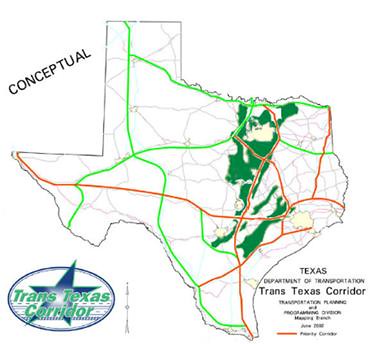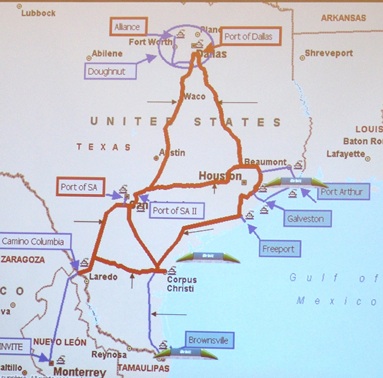Planning group to discuss second round of demand letters to TxDOTPolk County Enterprise
Copyright 2008
TRINITY — The Trinity-Neches Texas Sub-Regional Planning Commission will meet at 9 a.m. Wednesday in the Trinity City Hall to discuss sending second letters to the Texas Department of Transportation and the Environmental Protection Agency demanding a meeting to discuss the impact of the proposed Trans Texas Corridor through the region.
Recording Secretary Connie Fogle said the most recent documents sent to the Federal Highway Administration by TxDOT do not bind the state agency to construction along existing highways. The proposed superhighway would be devastating to school districts in Trinity County.
Groveton ISD would be split in two by the highway, she said. The route also plows through environmentally sensitive areas, she added. The loss of timber acreage along would have a major economic impact on a region that depends on timber and tourism, Fogle said. The timber producers would not be the only ones impacted, though. The latest maps continue to divide grazing areas used by cattle ranchers.
These second letters will demand a meeting with the planning commission within two weeks, Fogle said. The group will decide the location, time, date and agenda for the meeting with TxDOT and the EPA during Wednesday’s meeting.
The planning commission also plans to hold a preparatory meeting workshop prior to the meeting with the two agencies. The planning commission also will have an open forum for members of the public and associate members to discuss their concerns about the Trans-Texas Corridor.
The planning commission sent a letter to Richard Greene, administrator for the EPA’s Region 6 on June 18 that advised him of the creation of the planning commission under Chapter 391 of the Texas Local Government Code. The purpose of the group is to coordinate projects that affect the cities of Groveton, Corrigan and Trinity, especially the I-69 Trans-Texas Corridor.
After the group formed, Groveton ISD, Apple Springs ISD, Corrigan-Camden ISD, Pennington, Trinity Rural Water District and Glendale Water District joined the commission. It now covers 607,233 acres. The EPA letter signed by each of the mayors on the commission states the commission’s belief that draft environmental impact statement for I-69/TTC does not address the issues that will severely impact the area. “The DEIS is grossly inadequate in every criteria of study called for by NEPA,” the EPA letter states.
“We believe the primary reason the study is inadequate is because the agency in charge, the Texas Department of Transportation, has utterly failed to coordinate its ‘study’ with the local governments and the citizens of our community. There have been no meaningful discussions with the local governments in our area with regard to the specifi c impacts on transportation, economic, or social interests of our citizens.”
The letter continues by stating that the interpretation of the National Environmental Policy Act by the courts have made it clear that the impact study is not to be completed based on the preconceived idea that the studied project is to be completed regardless of the adverse effects on the human environment.
The several failures to comply with NEPA are listed in the letter as follows: Coordination with local government is a mandated method for the project planners to gain vital information as to the impact of the project on local government, which bears the burden of providing services to the public, the letter says.
For example, the I-69/TTC DEIS lacks equal consideration of the human and natural environment. Even in its non-specific treatment of the impact, the study weighs these critical impacts differently. Specifically, the study discusses the impact to wildlife, the need to mitigate wildlife corridors, and even the consideration of wildlife bridges and tunnels.
It includes a map of the potential mitigation area for the replacement properties for the protection of species, yet makes no mention of the human impact, such as the redistricting our schools, rerouting our school buses, or ensuring our first responders can reach the life threatening emergencies upon which our citizens depend.
This one-sided analysis points to the very reason Congress directed the agencies to coordinate this study with local governments, which the Texas Department of Transportation has failed to do.
While consideration of the impact to wildlife is being discussed, there is no analysis of the human impact and specifi cally the impact on the timber industry, which is the economic backbone of our community. For example, one logging contractor in our area employs 43 individuals and pays approximately $1.2 million in wages annually. These employees live in our community.
© 2008, The Polk County Enterprise:
www.easttexasnews.com









